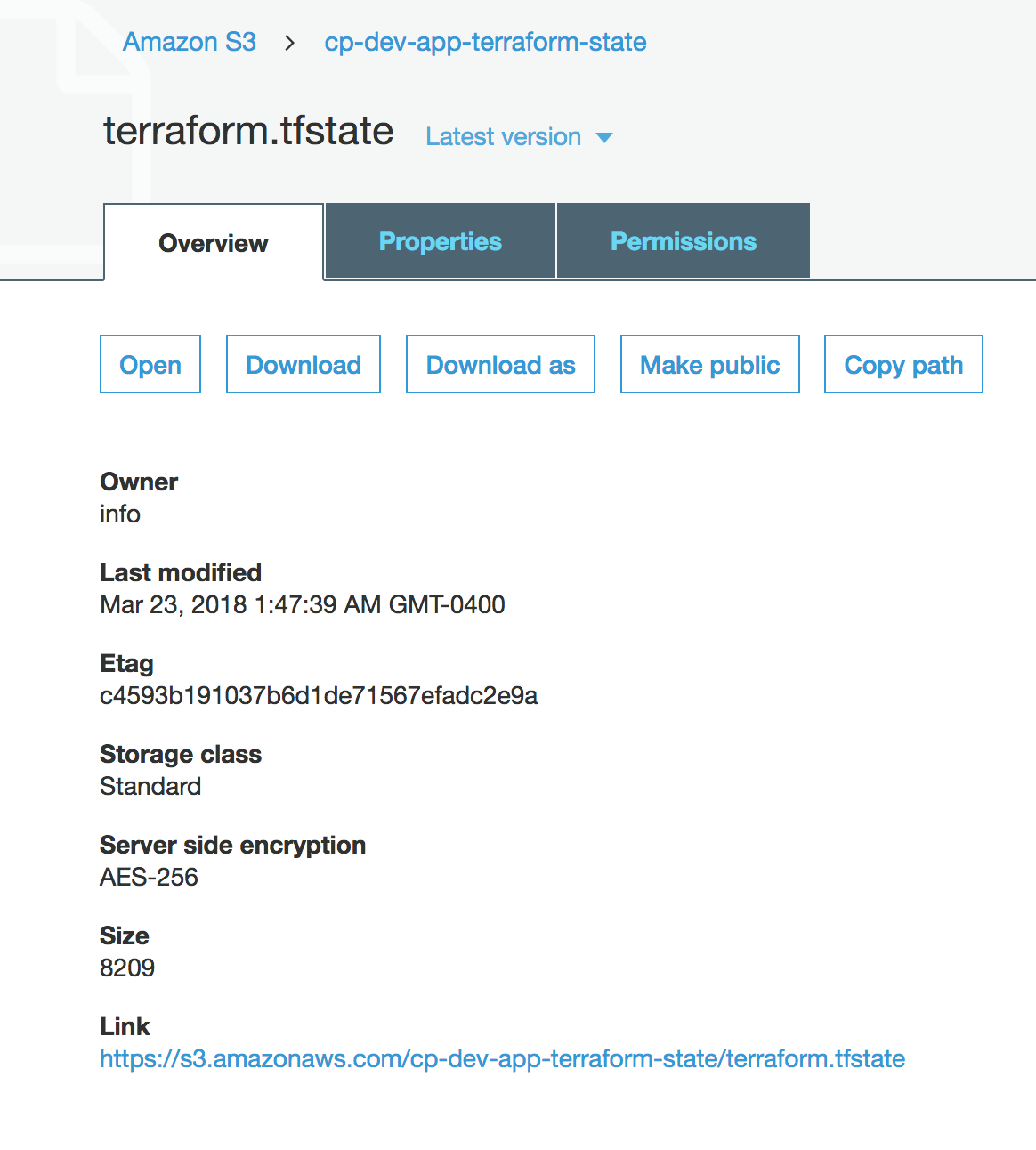terraform-aws-tfstate-backend 

Terraform module to provision an S3 bucket to store terraform.tfstate file and a DynamoDB table to lock the state file
to prevent concurrent modifications and state corruption.
The module supports the following:
- Forced server-side encryption at rest for the S3 bucket
- S3 bucket versioning to allow for Terraform state recovery in the case of accidental deletions and human errors
- State locking and consistency checking via DynamoDB table to prevent concurrent operations
- DynamoDB server-side encryption
https://www.terraform.io/docs/backends/types/s3.html
NOTE: The operators of the module (IAM Users) must have permissions to create S3 buckets and DynamoDB tables when performing terraform plan and terraform apply
NOTE: This module cannot be used to apply changes to the mfa_delete feature of the bucket. Changes regarding mfa_delete can only be made manually using the root credentials with MFA of the AWS Account where the bucket resides. Please see: hashicorp/terraform-provider-aws#62
This project is part of our comprehensive "SweetOps" approach towards DevOps.
It's 100% Open Source and licensed under the APACHE2.
We literally have hundreds of terraform modules that are Open Source and well-maintained. Check them out!
Usage
IMPORTANT: The master branch is used in source just as an example. In your code, do not pin to master because there may be breaking changes between releases.
Instead pin to the release tag (e.g. ?ref=tags/x.y.z) of one of our latest releases.
Create
Follow this procedure just once to create your deployment.
-
Add the
terraform_state_backendmodule to yourmain.tffile. The comment will help you remember to follow this procedure in the future:# You cannot create a new backend by simply defining this and then # immediately proceeding to "terraform apply". The S3 backend must # be bootstrapped according to the simple yet essential procedure in # https://github.com/cloudposse/terraform-aws-tfstate-backend#usage module "terraform_state_backend" { source = "git::https://github.com/cloudposse/terraform-aws-tfstate-backend.git?ref=master" namespace = "eg" stage = "test" name = "terraform" attributes = ["state"] region = "us-east-1" terraform_backend_config_file_path = "." terraform_backend_config_file_name = "backend.tf" force_destroy = false } # Your Terraform configuration module "another_module" { source = "....." }
Module inputs
terraform_backend_config_file_pathandterraform_backend_config_file_namecontrol the name of the backend definition file. Note that whenterraform_backend_config_file_pathis empty (the default), no file is created. -
terraform init. This downloads Terraform modules and providers. -
terraform apply -auto-approve. This creates the state bucket and DynamoDB locking table, along with anything else you have defined in your*.tffile(s). At this point, the Terraform state is still stored locally.Module
terraform_state_backendalso creates a newbackend.tffile that defines the S3 state backend. For example:backend "s3" { region = "us-east-1" bucket = "< the name of the S3 state bucket >" key = "terraform.tfstate" dynamodb_table = "< the name of the DynamoDB locking table >" profile = "" role_arn = "" encrypt = true }
Henceforth, Terraform will also read this newly-created backend definition file.
-
terraform init -force-copy. Terraform detects that you want to move your Terraform state to the S3 backend, and it does so per-auto-approve. Now the state is stored in the S3 bucket, and the DynamoDB table will be used to lock the state to prevent concurrent modification.
This concludes the one-time preparation. Now you can extend and modify your Terraform configuration as usual.
Destroy
Follow this procedure to delete your deployment.
- In
main.tf, change theterraform_state_backendmodule arguments as follows:module "terraform_state_backend" { ... terraform_backend_config_file_path = "" force_destroy = true }
terraform apply -target module.terraform_state_backend -auto-approve. This implements the above modifications by deleting thebackend.tffile and enabling deletion of the S3 state bucket.terraform init -force-copy. Terraform detects that you want to move your Terraform state from the S3 backend to local files, and it does so per-auto-approve. Now the state is once again stored locally and the S3 state bucket can be safely deleted.terraform destroy. This deletes all resources in your deployment.- Examine local state file
terraform.tfstateto verify that it contains no resources.
Makefile Targets
Available targets:
help Help screen
help/all Display help for all targets
help/short This help short screen
lint Lint terraform code
Requirements
| Name | Version |
|---|---|
| terraform | >= 0.12.0, < 0.14.0 |
| aws | ~> 2.0 |
| local | ~> 1.2 |
| null | ~> 2.0 |
| template | ~> 2.0 |
Providers
| Name | Version |
|---|---|
| aws | ~> 2.0 |
| local | ~> 1.2 |
| template | ~> 2.0 |
Inputs
| Name | Description | Type | Default | Required |
|---|---|---|---|---|
| acl | The canned ACL to apply to the S3 bucket | string |
"private" |
no |
| additional_tag_map | Additional tags for appending to each tag map | map(string) |
{} |
no |
| arn_format | ARN format to be used. May be changed to support deployment in GovCloud/China regions. | string |
"arn:aws" |
no |
| attributes | Additional attributes (e.g. state) |
list(string) |
[ |
no |
| billing_mode | DynamoDB billing mode | string |
"PROVISIONED" |
no |
| block_public_acls | Whether Amazon S3 should block public ACLs for this bucket | bool |
true |
no |
| block_public_policy | Whether Amazon S3 should block public bucket policies for this bucket | bool |
true |
no |
| context | Default context to use for passing state between label invocations | object({ |
{ |
no |
| delimiter | Delimiter to be used between namespace, environment, stage, name and attributes |
string |
"-" |
no |
| enable_point_in_time_recovery | Enable DynamoDB point-in-time recovery | bool |
false |
no |
| enable_public_access_block | Enable Bucket Public Access Block | bool |
true |
no |
| enable_server_side_encryption | Enable DynamoDB server-side encryption | bool |
true |
no |
| environment | Environment, e.g. 'prod', 'staging', 'dev', 'pre-prod', 'UAT' | string |
"" |
no |
| force_destroy | A boolean that indicates the S3 bucket can be destroyed even if it contains objects. These objects are not recoverable | bool |
false |
no |
| ignore_public_acls | Whether Amazon S3 should ignore public ACLs for this bucket | bool |
true |
no |
| label_order | The naming order of the id output and Name tag | list(string) |
[] |
no |
| mfa_delete | A boolean that indicates that versions of S3 objects can only be deleted with MFA. ( Terraform cannot apply changes of this value; hashicorp/terraform-provider-aws#629 ) | bool |
false |
no |
| name | Solution name, e.g. 'app' or 'jenkins' | string |
"terraform" |
no |
| namespace | Namespace, which could be your organization name or abbreviation, e.g. 'eg' or 'cp' | string |
"" |
no |
| prevent_unencrypted_uploads | Prevent uploads of unencrypted objects to S3 | bool |
true |
no |
| profile | AWS profile name as set in the shared credentials file | string |
"" |
no |
| read_capacity | DynamoDB read capacity units | number |
5 |
no |
| regex_replace_chars | Regex to replace chars with empty string in namespace, environment, stage and name. By default only hyphens, letters and digits are allowed, all other chars are removed |
string |
"/[^a-zA-Z0-9-]/" |
no |
| region | AWS Region the S3 bucket should reside in | string |
n/a | yes |
| restrict_public_buckets | Whether Amazon S3 should restrict public bucket policies for this bucket | bool |
true |
no |
| role_arn | The role to be assumed | string |
"" |
no |
| s3_bucket_name | S3 bucket name. If not provided, the name will be generated by the label module in the format namespace-stage-name | string |
"" |
no |
| stage | Stage, e.g. 'prod', 'staging', 'dev', OR 'source', 'build', 'test', 'deploy', 'release' | string |
"" |
no |
| tags | Additional tags (e.g. map('BusinessUnit','XYZ') |
map(string) |
{} |
no |
| terraform_backend_config_file_name | Name of terraform backend config file | string |
"terraform.tf" |
no |
| terraform_backend_config_file_path | Directory for the terraform backend config file, usually .. The default is to create no file. |
string |
"" |
no |
| terraform_backend_config_template_file | The path to the template used to generate the config file | string |
"" |
no |
| terraform_state_file | The path to the state file inside the bucket | string |
"terraform.tfstate" |
no |
| terraform_version | The minimum required terraform version | string |
"0.12.2" |
no |
| write_capacity | DynamoDB write capacity units | number |
5 |
no |
Outputs
| Name | Description |
|---|---|
| dynamodb_table_arn | DynamoDB table ARN |
| dynamodb_table_id | DynamoDB table ID |
| dynamodb_table_name | DynamoDB table name |
| s3_bucket_arn | S3 bucket ARN |
| s3_bucket_domain_name | S3 bucket domain name |
| s3_bucket_id | S3 bucket ID |
| terraform_backend_config | Rendered Terraform backend config file |
Share the Love
Like this project? Please give it a ★ on our GitHub! (it helps us a lot)
Are you using this project or any of our other projects? Consider leaving a testimonial. =)
Related Projects
Check out these related projects.
- terraform-aws-dynamodb - Terraform module that implements AWS DynamoDB with support for AutoScaling
- terraform-aws-dynamodb-autoscaler - Terraform module to provision DynamoDB autoscaler
Help
Got a question? We got answers.
File a GitHub issue, send us an email or join our Slack Community.
DevOps Accelerator for Startups
We are a DevOps Accelerator. We'll help you build your cloud infrastructure from the ground up so you can own it. Then we'll show you how to operate it and stick around for as long as you need us.
Work directly with our team of DevOps experts via email, slack, and video conferencing.
We deliver 10x the value for a fraction of the cost of a full-time engineer. Our track record is not even funny. If you want things done right and you need it done FAST, then we're your best bet.
- Reference Architecture. You'll get everything you need from the ground up built using 100% infrastructure as code.
- Release Engineering. You'll have end-to-end CI/CD with unlimited staging environments.
- Site Reliability Engineering. You'll have total visibility into your apps and microservices.
- Security Baseline. You'll have built-in governance with accountability and audit logs for all changes.
- GitOps. You'll be able to operate your infrastructure via Pull Requests.
- Training. You'll receive hands-on training so your team can operate what we build.
- Questions. You'll have a direct line of communication between our teams via a Shared Slack channel.
- Troubleshooting. You'll get help to triage when things aren't working.
- Code Reviews. You'll receive constructive feedback on Pull Requests.
- Bug Fixes. We'll rapidly work with you to fix any bugs in our projects.
Slack Community
Join our Open Source Community on Slack. It's FREE for everyone! Our "SweetOps" community is where you get to talk with others who share a similar vision for how to rollout and manage infrastructure. This is the best place to talk shop, ask questions, solicit feedback, and work together as a community to build totally sweet infrastructure.
Discourse Forums
Participate in our Discourse Forums. Here you'll find answers to commonly asked questions. Most questions will be related to the enormous number of projects we support on our GitHub. Come here to collaborate on answers, find solutions, and get ideas about the products and services we value. It only takes a minute to get started! Just sign in with SSO using your GitHub account.
Newsletter
Sign up for our newsletter that covers everything on our technology radar. Receive updates on what we're up to on GitHub as well as awesome new projects we discover.
Office Hours
Join us every Wednesday via Zoom for our weekly "Lunch & Learn" sessions. It's FREE for everyone!
Contributing
Bug Reports & Feature Requests
Please use the issue tracker to report any bugs or file feature requests.
Developing
If you are interested in being a contributor and want to get involved in developing this project or help out with our other projects, we would love to hear from you! Shoot us an email.
In general, PRs are welcome. We follow the typical "fork-and-pull" Git workflow.
- Fork the repo on GitHub
- Clone the project to your own machine
- Commit changes to your own branch
- Push your work back up to your fork
- Submit a Pull Request so that we can review your changes
NOTE: Be sure to merge the latest changes from "upstream" before making a pull request!
Copyright
Copyright © 2017-2020 Cloud Posse, LLC
License
See LICENSE for full details.
Licensed to the Apache Software Foundation (ASF) under one
or more contributor license agreements. See the NOTICE file
distributed with this work for additional information
regarding copyright ownership. The ASF licenses this file
to you under the Apache License, Version 2.0 (the
"License"); you may not use this file except in compliance
with the License. You may obtain a copy of the License at
https://www.apache.org/licenses/LICENSE-2.0
Unless required by applicable law or agreed to in writing,
software distributed under the License is distributed on an
"AS IS" BASIS, WITHOUT WARRANTIES OR CONDITIONS OF ANY
KIND, either express or implied. See the License for the
specific language governing permissions and limitations
under the License.
Trademarks
All other trademarks referenced herein are the property of their respective owners.
About
This project is maintained and funded by Cloud Posse, LLC. Like it? Please let us know by leaving a testimonial!
We're a DevOps Professional Services company based in Los Angeles, CA. We ❤️ Open Source Software.
We offer paid support on all of our projects.
Check out our other projects, follow us on twitter, apply for a job, or hire us to help with your cloud strategy and implementation.
Contributors
 Andriy Knysh |
 Erik Osterman |
 Maarten van der Hoef |
 Vladimir |
 Chris Weyl |
 John McGehee |
 Oliver L Schoenborn |
|---|





